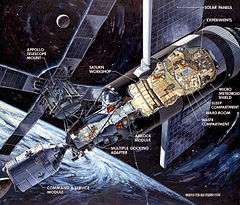Skylab
.jpg) Skylab as photographed by its departing final crew (Skylab 4) | |
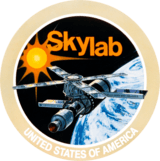 Skylab program insignia | |
| Station statistics | |
|---|---|
| COSPAR ID | 1973-027A |
| Call sign | Skylab |
| Crew | 3 per mission (9 total) |
| Launch |
May 14, 1973 17:30:00 UTC |
| Launch pad | Kennedy Space Center LC-39A |
| Reentry |
July 11, 1979 16:37:00 UTC near Perth, Australia |
| Mission status | Complete |
| Mass |
170,000 lb (77,111 kg)[1] w/o Apollo CSM |
| Length |
82.4 feet (25.1 m) w/o Apollo CSM |
| Width |
55.8 feet (17.0 m) w/ one solar panel |
| Height |
36.3 feet (11.1 m) w/ telescope mount |
| Diameter | 21.67 feet (6.6 m) |
| Pressurised volume | 12,417 cu ft (351.6 m3) |
| Perigee | 269.7 mi (434.0 km) |
| Apogee | 274.6 mi (441.9 km) |
| Orbital inclination | 50° |
| Orbital period | 93.4 min |
| Orbits per day | 15.4 |
| Days in orbit | 2,249 days |
| Days occupied | 171 days |
| No. of orbits | 34,981 |
| Distance travelled | ~890,000,000 mi (1,400,000,000 km) |
| Statistics as of Re-entry July 11, 1979 | |
| Configuration | |
|
Skylab configuration as planned | |
| Part of a series of articles on the |
| Space policy of the United States |
|---|
 |
Skylab was the United States' first space station, orbiting Earth from 1973 to 1979, when it fell back to Earth amid huge worldwide media attention. Launched and operated by NASA, Skylab included a workshop, a solar observatory, and other systems necessary for crew survival and scientific experiments. It was launched unmanned by a modified Saturn V rocket, with a weight of 170,000 pounds (77,111 kg). Lifting Skylab into low earth orbit was the final mission and launch of a Saturn V rocket (which was famous for carrying the manned Moon landing missions).[2] Skylab was not simply a place of habitation; massive science experimentation was undertaken there. When data from these experiments (some of which were on physical film) were returned to Earth, analysis of scientific and engineering data of each mission was completed. Skylab's solar observatory was one of its major functions. Solar science was significantly advanced by the telescope, and its observation of the Sun was unprecedented. As the Skylab program drew to a close, NASA's focus had shifted to the development of the Space Shuttle, through which NASA hoped to reduce the cost of space access compared to previous launch systems.
To transport astronauts to Skylab, there were a total of three manned expeditions to the station, conducted between May 1973 and February 1974. Each of these missions delivered a three-astronaut crew, carried in the Apollo Command/Service Module (Apollo CSM) launched atop the Saturn IB rocket, which is much smaller than the Saturn V. For the final two manned missions to Skylab, a backup Apollo CSM/Saturn IB was assembled and made ready in case an in-orbit rescue mission was needed, but this backup vehicle was never flown.
The station was damaged during launch when the micrometeoroid shield separated from the workshop and tore away, taking one of the main solar panel arrays with it and jamming the other main solar panel array so that it could not deploy. This deprived Skylab of most of its electrical power, and also removed protection from intense solar heating, threatening to make it unusable. However, the first crew was able to save Skylab by deploying a replacement heat shade and freeing the jammed solar panels. This was the first time a repair of this magnitude was performed in space.
Skylab included the Apollo Telescope Mount (a multi-spectral solar observatory), Multiple Docking Adapter (with two docking ports), Airlock Module with extravehicular activity (EVA) hatches, and the Orbital Workshop (the main habitable space inside Skylab). Electrical power came from solar arrays, as well as fuel cells in the docked Apollo CSM. The rear of the station included a large waste tank, propellant tanks for maneuvering jets, and a heat radiator.
Numerous scientific experiments were conducted aboard Skylab during its operational life, and crews were able to confirm the existence of coronal holes in the Sun. The Earth Resources Experiment Package (EREP) was used to view Earth with sensors that recorded data in the visible, infrared, and microwave spectral regions. Thousands of photographs of Earth were taken, and the record for human time spent in orbit was extended beyond the 23 days set by the Soyuz 11 crew aboard Salyut 1, to as much as 84 days by the Skylab 4 crew. Plans were made to refurbish and reuse Skylab by using the Space Shuttle to boost its orbit and repair it. However, due to delays with the development of the Space Shuttle, Skylab's decaying orbit could not be stopped.
In the hours before re-entry, NASA ground controllers attempted to adjust Skylab's trajectory and orientation to try to minimize the risk of debris landing in populated areas.[3] NASA's attempted target was a spot 810 miles (1,300 km) south-southeast of Cape Town, South Africa. Skylab's atmospheric reentry began on July 11, 1979,[4] and people on earth and an airline pilot saw dozens of colorful firework-like flares as large pieces of the space station broke up in the atmosphere.[5] Skylab did not burn up as fast as NASA expected, and Skylab debris landed southeast of Perth in Western Australia, resulting in a debris path between Esperance and Rawlinna.[4] Over a single property in Esperance, 24 pieces of Skylab were found.[4][5] Analysis of some debris indicated that the Skylab station had disintegrated 10 mi (16 km) above the Earth, much lower than expected.[5]
After Skylab, NASA space station/laboratory projects included Spacelab, Shuttle-Mir, and Space Station Freedom (which was later merged into the International Space Station).
Background
Rocket engineer Wernher von Braun, science fiction writer Arthur C. Clarke, and other early advocates of manned space travel, expected until the 1960s that a space station would be an important early step in space exploration. Von Braun participated in the publishing of a series of influential articles in Collier's magazine from 1952 to 1954, titled "Man Will Conquer Space Soon!". He envisioned a large, circular station 250 feet (75m) in diameter that would rotate to generate artificial gravity and require a fleet of 7,000-ton (6,500-metric ton) space shuttles for construction in orbit. The 80 men aboard the station would include astronomers operating a telescope, meteorologists to forecast the weather, and soldiers to conduct surveillance. Von Braun expected that future expeditions to the Moon and Mars would leave from the station.[6]
The development of the transistor, the solar cell, and telemetry, led in the 1950s and early 1960s to unmanned satellites that could take photographs of weather patterns or enemy nuclear weapons and send them to Earth. A large station was no longer necessary for such purposes, and the United States Apollo program to send men to the Moon chose a mission mode that would not need in-orbit assembly. A smaller station that a single rocket could launch retained value, however, for scientific purposes.[7]
Early studies
In 1959, von Braun, head of the Development Operations Division at the Army Ballistic Missile Agency, submitted his final Project Horizon plans to the U.S. Army. The overall goal of Horizon was to place men on the Moon, a mission that would soon be taken over by the rapidly forming NASA. Although concentrating on the Moon missions, von Braun also detailed an orbiting laboratory built out of a Horizon upper stage,[8] an idea used for Skylab.[9] A number of NASA centers studied various space station designs in the early 1960s. Studies generally looked at platforms launched by the Saturn V, followed up by crews launched on Saturn IB using an Apollo Command/Service Module,[10] or a Gemini capsule[11] on a Titan II-C, the latter being much less expensive in the case where cargo was not needed. Proposals ranged from an Apollo-based station with two to three men, or a small "canister" for four men with Gemini capsules resupplying it, to a large, rotating station with 24 men and an operating lifetime of about five years.[12] A proposal to study the use of a Saturn S-IVB as a manned space laboratory was documented in 1962 by the Douglas Aircraft Company.[13]
Air Force plans
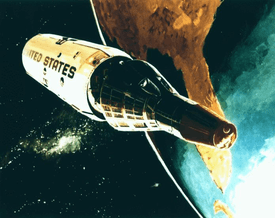
The Department of Defense (DoD) and NASA cooperated closely in many areas of space.[14] In September 1963, NASA and the DoD agreed to cooperate in building a space station.[15] The DoD wanted its own manned facility, however,[16] and in December it announced Manned Orbital Laboratory (MOL), a small space station primarily intended for photo reconnaissance using large telescopes directed by a two-man crew. The station was the same diameter as a Titan II upper stage, and would be launched with the crew riding atop in a modified Gemini capsule with a hatch cut into the heat shield on the bottom of the capsule.[17][18][19] MOL competed for funding with a NASA station for the next five years[20] and politicians and other officials often suggested that NASA participate in MOL or use the DoD design.[16] The military project led to changes to the NASA plans so that they would resemble MOL less.[15]
Development

Apollo Applications Program
NASA management was concerned about losing the 400,000 workers involved in Apollo after landing on the Moon in 1969.[21] A reason von Braun, head of NASA's Marshall Space Flight Center during the 1960s, advocated for a smaller station after his large one was not built was that he wished to provide his employees with work beyond developing the Saturn rockets, which would be completed relatively early during Project Apollo.[22] NASA set up the Apollo Logistic Support System Office, originally intended to study various ways to modify the Apollo hardware for scientific missions. The office initially proposed a number of projects for direct scientific study, including an extended-stay lunar mission which required two Saturn V launchers, a "lunar truck" based on the Lunar Module (LEM), a large manned solar telescope using a LEM as its crew quarters, and small space stations using a variety of LEM or CSM-based hardware. Although it did not look at the space station specifically, over the next two years the office would become increasingly dedicated to this role. In August 1965, the office was renamed, becoming the Apollo Applications Program (AAP).[23]
As part of their general work, in August 1964 the Manned Spacecraft Center (MSC) presented studies on an expendable lab known as Apollo "X", short for Apollo Extension System. "Apollo X" would have replaced the LEM carried on the top of the S-IVB stage with a small space station slightly larger than the CSM's service area, containing supplies and experiments for missions between 15 and 45 days' duration. Using this study as a baseline, a number of different mission profiles were looked at over the next six months.
Wet workshop

In November 1964, von Braun proposed a more ambitious plan to build a much larger station built from the S-II second stage of a Saturn V. His design replaced the S-IVB third stage with an aeroshell, primarily as an adapter for the CSM on top. Inside the shell was a 10-foot (3.0 m) cylindrical equipment section. On reaching orbit, the S-II second stage would be vented to remove any remaining hydrogen fuel, then the equipment section would be slid into it via a large inspection hatch. This became known as a "wet workshop" concept, because of the conversion of an active fuel tank. The station filled the entire interior of the S-II stage's hydrogen tank, with the equipment section forming a "spine" and living quarters located between it and the walls of the booster. This would have resulted in a very large 33-by-45-foot (10.1 by 13.7 m) living area. Power was to be provided by solar cells lining the outside of the S-II stage.[24]
One problem with this proposal was that it required a dedicated Saturn V launch to fly the station. At the time the design was being proposed, it was not known how many of the then-contracted Saturn Vs would be required to achieve a successful Moon landing. However, several planned Earth-orbit test missions for the LEM and CSM had been canceled, leaving a number of Saturn IBs free for use. Further work led to the idea of building a smaller "wet workshop" based on the S-IVB, launched as the second stage of a Saturn IB.
A number of S-IVB-based stations were studied at MSC from mid-1965, which had much in common with the Skylab design that eventually flew. An airlock would be attached to the hydrogen tank, in the area designed to hold the LEM, and a minimum amount of equipment would be installed in the tank itself in order to avoid taking up too much fuel volume. Floors of the station would be made from an open metal framework that allowed the fuel to flow through it. After launch, a follow-up mission launched by a Saturn IB would launch additional equipment, including solar panels, an equipment section and docking adapter, and various experiments. Douglas Aircraft, builder of the S-IVB stage, was asked to prepare proposals along these lines. The company had for several years been proposing stations based on the S-IV stage, before it was replaced by the S-IVB.[25]

On April 1, 1966, MSC sent out contracts to Douglas, Grumman, and McDonnell for the conversion of a S-IVB spent stage, under the name Saturn S-IVB spent-stage experiment support module (SSESM).[26] In May, astronauts voiced concerns over the purging of the stage's hydrogen tank in space. Nevertheless, in late July it was announced that the Orbital Workshop would be launched as a part of Apollo mission AS-209, originally one of the Earth-orbit CSM test launches, followed by two Saturn I/CSM crew launches, AAP-1 and AAP-2.
MOL remained AAP's chief competitor for funds, although the two programs cooperated on technology. NASA considered flying experiments on MOL, or using its Titan IIIC booster instead of the much more expensive Saturn IB. The agency decided that the Air Force station was not large enough, and that converting Apollo hardware for use with Titan would be too slow and too expensive.[27] The DoD later canceled MOL in June 1969.[28]
Dry workshop
Design work continued over the next two years, in an era of shrinking budgets.[29] (NASA sought $450 million for Apollo Applications in fiscal year 1967, for example, but received $42 million.)[30] In August 1967, the agency announced that the lunar mapping and base construction missions examined by the AAP were being canceled. Only the Earth-orbiting missions remained, namely the Orbital Workshop and Apollo Telescope Mount solar observatory.
The success of Apollo 8 in December 1968, launched on the third flight of a Saturn V, made it likely that one would be available to launch a dry workshop.[31] Later, several Moon missions were canceled as well, originally to be Apollo missions 18 through 20. The cancellation of these missions freed up three Saturn V boosters for the AAP program. Although this would have allowed them to develop von Braun's original S-II based mission, by this time so much work had been done on the S-IV based design that work continued on this baseline. With the extra power available, the wet workshop was no longer needed;[32] the S-IC and S-II lower stages could launch a "dry workshop", with its interior already prepared, directly into orbit.
Habitability

A dry workshop simplified plans for the interior of the station.[33] Industrial design firm Raymond Loewy/William Snaith recommended emphasizing habitability and comfort for the astronauts by, for example, providing a wardroom for meals and relaxation,[34] and a window to view Earth and space, although astronauts who participated in Skylab planning were dubious about the designers' focus on areas such as color schemes.[35] Habitability had not previously been an area of concern when building spacecraft, due to their small volume and brief mission durations, but the Skylab missions would last for months.[36] NASA sent a scientist on Jacques Piccard's Ben Franklin submarine in the Gulf Stream in July and August 1969, to learn how six people would live in an enclosed space for four weeks.[37]
Astronauts were uninterested in watching movies on a proposed entertainment center or playing games, but did want books and individual music choices.[35] Food was also important; early Apollo crews complained about its quality, and a NASA volunteer found living on the Apollo food for four days on Earth to be intolerable; its taste and composition, in the form of cubes and squeeze tubes, were unpleasant. Skylab food significantly improved on its predecessors by prioritizing edibility over scientific needs.[38]
Each astronaut had a private sleeping area the size of a small walk-in closet, with a curtain, sleeping bag, and locker.[39] Designers also added a shower[40][41] and a toilet;[42][43] the latter was both for comfort and to obtain precise urine and feces samples for examination on Earth.[44]
Waste was put in a large waste tank that occupied a large section of below the OWS. Although Skylab did not have a system to recycle urine into drinking water for example, it also did not dump trash into space to dispose of it. Trash and waste water were put in the trash airlock, which injected it into the big waste tank. Its contents re-entered Earth's atmosphere with the rest of Skylab in 1979.
Rescue
Rescuing astronauts from Skylab was possible in the most likely emergency circumstances. The crew could use the CSM to quickly return to Earth if the station suffered serious damage. If the CSM failed, the spacecraft and Saturn IB for the next Skylab mission would have been launched with two astronauts to retrieve the crew; given Skylab's ample supplies, its residents would have been able to wait up to several weeks for the rescue mission.[45]
Components
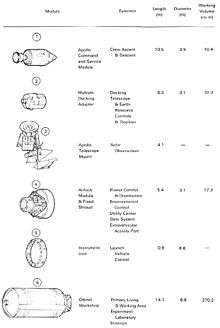
| Component | Mass[2][46][47] | Habitable Volume | Length | Diameter |
|---|---|---|---|---|
| Payload shroud | 25,600 pounds (11,600 kg) | — | 56.0 feet (17.1 m) | 21.6 feet (6.6 m) |
| Apollo Telescope Mount | 24,500 pounds (11,100 kg) | — | 14.7 feet (4.5 m) | 11.3 feet (3.4 m) |
| Multiple Docking Adapter | 12,000 pounds (5,400 kg) | 1,140 cubic feet (32 m3) | 17.3 feet (5.3 m) | 10.5 feet (3.2 m) |
| Airlock module | 49,000 pounds (22,000 kg) | 613 cubic feet (17.4 m3) | 17.6 feet (5.4 m) | 10.5 feet (3.2 m) |
| Instrument Unit | 4,600 pounds (2,100 kg) | — | 3.0 feet (0.91 m) | 21.6 feet (6.6 m) |
| Orbital Workshop | 78,000 pounds (35,000 kg) | 10,664 cubic feet (302.0 m3) | 48.1 feet (14.7 m) | 21.6 feet (6.6 m) |
| Total in orbit | 195,300 pounds (88,600 kg) | 12,417 cubic feet (351.6 m3) | 82.4 feet (25.1 m) | 21.6 feet (6.6 m) |
| Apollo CSM | 31,000 pounds (14,000 kg) | 210 cubic feet (5.9 m3) | 36.1 feet (11.0 m) | 12.8 feet (3.9 m) |
| Total with CSM | 199,750 pounds (90,610 kg) | 12,627 cubic feet (357.6 m3) | 118.5 feet (36.1 m) | 21.6 feet (6.6 m) |
Operational history
Completion and launch

On August 8, 1969, the McDonnell Douglas Corporation received a contract for the conversion of two existing S-IVB stages to the Orbital Workshop configuration. One of the S-IV test stages was shipped to McDonnell Douglas for the construction of a mock-up in January 1970. The Orbital Workshop was renamed "Skylab" in February 1970 as a result of a NASA contest.[48] The actual stage that flew was the upper stage of the AS-212 rocket (the S-IVB stage, S-IVB 212). The mission computer used aboard Skylab was the IBM System/4Pi TC-1, a relative of the AP-101 Space Shuttle computers. A Saturn V originally produced for the Apollo program—before the cancellation of Apollo 18, 19, and 20—was repurposed and redesigned to launch Skylab.[49] The Saturn V's upper stage was removed, but with the controlling Instrument Unit remaining in its standard position.
Skylab was launched on May 14, 1973 by the modified Saturn V. The launch is sometimes referred to as Skylab 1, or SL-1. Severe damage was sustained during launch and deployment, including the loss of the station's micrometeoroid shield/sun shade and one of its main solar panels. Debris from the lost micrometeoroid shield further complicated matters by pinning the remaining solar panel to the side of the station, preventing its deployment and thus leaving the station with a huge power deficit.[50]
Immediately following Skylab's launch, Pad A at Kennedy Space Center Launch Complex 39 was deactivated, and construction proceeded to modify it for the Space Shuttle program, originally targeting a maiden launch in March 1979. The manned missions to Skylab would occur using a Saturn IB rocket from Launch Pad 39B.
SL-1 would be the final unmanned launch from LC-39 until February 19, 2017, when SpaceX CRS-10 was launched.
Manned missions



Three manned missions, designated SL-2, SL-3 and SL-4, were made to Skylab. The first manned mission, SL-2, launched on May 25, 1973 atop a Saturn IB and involved extensive repairs to the station. The crew deployed a parasol-like sunshade through a small instrument port from the inside of the station bringing station temperatures down to acceptable levels and preventing overheating that would have melted the plastic insulation inside the station and released poisonous gases. This solution was designed by NASA's "Mr. Fix It" Jack Kinzler, who won the NASA Distinguished Service Medal for his efforts. The crew conducted further repairs via two spacewalks (extra-vehicular activity, or EVA). The crew stayed in orbit with Skylab for 28 days. Two additional missions followed, with the launch dates of July 28, 1973 (SL-3) and November 16, 1973 (SL-4), and mission durations of 59 and 84 days, respectively. The last Skylab crew returned to Earth on February 8, 1974.
In addition to the three manned missions, there was a Rescue mission on standby that had a crew of two, but could take 5 back down.
- Skylab 2: launched May 25, 1973
- Skylab 3: launched July 28, 1973
- Skylab 4: launched November 16, 1973
- Skylab 5: cancelled
- Skylab Rescue on standby
Also of note was the three-man crew of Skylab Medical Experiment Altitude Test, who spent 56 days at low-pressure in 1972 on Earth.[52] This was a spaceflight analog test in full gravity, but various Skylab hardware and medical knowledge was gained
Orbital operations
| Mission |
|
|---|---|
| Skylab 2 | 28 |
| Skylab 3 | 60 |
| Skylab 4 | 84 |
Skylab orbited Earth 2,476 times during the 171 days and 13 hours of its occupation during the three manned Skylab expeditions. Each of these extended the human record of 23 days for amount of time spent in space set by the Soviet Soyuz 11 crew aboard the space station Salyut 1 on June 30, 1971. Skylab 2 lasted 28 days, Skylab 3 56 days, and Skylab 4 84 days. Astronauts performed ten spacewalks, totaling 42 hours and 16 minutes. Skylab logged about 2,000 hours of scientific and medical experiments, 127,000 frames of film of the Sun and 46,000 of Earth.[53] Solar experiments included photographs of eight solar flares, and produced valuable results[54] that scientists stated would have been impossible to obtain with unmanned spacecraft.[55] The existence of the Sun's coronal holes were confirmed because of these efforts.[56] Many of the experiments conducted investigated the astronauts' adaptation to extended periods of microgravity.

A typical day began at 6 AM Central Time Zone.[57] Although the toilet was small and noisy, both veteran astronauts—who had endured earlier missions' rudimentary waste-collection systems—and rookies complimented it.[58][41][59] The first crew enjoyed taking a shower once a week, but found drying themselves in weightlessness[59] and vacuuming excess water difficult; later crews usually cleaned themselves daily with wet washcloths instead of using the shower. Astronauts also found that bending over in weightlessness to put on socks or tie shoelaces strained their stomach muscles.[60]
Breakfast began at 7 AM. Astronauts usually stood to eat, as sitting in microgravity also strained their stomach muscles. They reported that their food—although greatly improved from Apollo—was bland and repetitive, and weightlessness caused utensils, food containers, and bits of food to float away; also, gas in their drinking water contributed to flatulence. After breakfast and preparation for lunch, experiments, tests and repairs of spacecraft systems and, if possible, 90 minutes of physical exercise followed; the station had a bicycle and other equipment, and astronauts could jog around the water tank. After dinner, which was scheduled for 6 PM, crews performed household chores and prepared for the next day's experiments. Following lengthy daily instructions (some of which were up to 15 meters long) sent via teleprinter, the crews were often busy enough to postpone sleep.[61][62]
The station offered what a later study called "a highly satisfactory living and working environment for crews", with enough room for personal privacy.[63] Although it had a dart set,[64] playing cards, and other recreational equipment in addition to books and music players, the window with its view of Earth became the most popular way to relax in orbit.[65]
Experiments
The figure lists an overview of most major experiments.[66] Skylab 4 carried out several more experiments, such as to observe Comet Kohoutek.

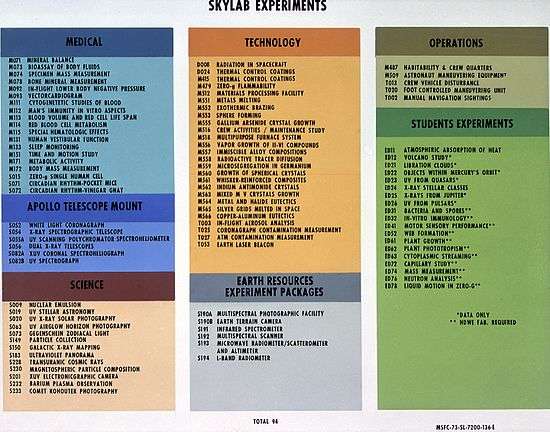
Film vaults and window radiation shield
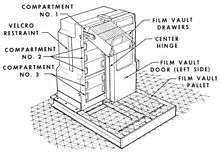
Skylab had certain features to protect vulnerable technology from radiation.[67] The window was vulnerable to darkening, and this darkening could affect experiment S190.[67] As a result, a light shield that could be open or shut was designed and installed on Skylab.[67] To protect a wide variety of films, used for a variety of experiments and for astronaut photography, there were 5 film vaults.[68] There were four smaller film vaults in the Multiple Docking Adapter, which had to have four not one, because each spar could not carry enough weight for single larger film vault.[68] The orbital workshop could handle a single larger safe, which is also more efficient for shielding.[68] The large vault in the orbital workshop had an empty mass of 2398 lb (1088 kg, 171.3 stones).[68][67] The four smaller vaults had combined mass of 1545 lb.[68] The primary construction material of all five safes was aluminum.[68] When Skylab re-entered there was one 180 lb chunk of aluminum found that was thought to be a door to one of the film vaults.[69] The big film vault was one of the heaviest single pieces of Skylab to re-enter Earth's atmosphere.[70]
A later example of a radiation vault is the Juno Radiation Vault for the Juno orbiter for Jupiter; in that case it was designed to protect much of the unmanned spacecraft's electronics and it used 1 cm thick walls of titanium.[71]
The film vault was used for storing film from various sources including the Apollo Telescope Mount solar instruments.[72] Six ATM experiments used film to record data, and over the course of the missions over 150, 000 successful exposures were recorded.[72] The film canister had to be manually retrieved on manned spacewalks to the instruments during the missions.[72] The film canisters were returned to Earth aboard the Apollo capsules when each mission ended, and were among the heaviest items that had to be returned at the end of each mission.[73] The heaviest canisters weighed 40 kg and could hold up to 16,000 frames of film.[73]
Gyroscopes
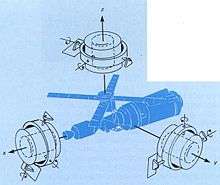
There were two types of gyroscopes on Skylab. Control-moment gyroscopes could physically move the station, and rate gyroscopes measured the rate of rotation to find its orientation. (see Control moment gyroscope (CMG))[74] The CMG helped provide the fine pointing needed by the Apollo Telescope Mount, and to resist various forces that can change the station's orientation.[75]
Some of the forces acting on Skylab that the pointing system needed to resist:[75]
- gravity gradient
- aerodynamic disturbance
- internal movements of crew
The Skylab-A attitude and pointing control system has been developed to meet the high accuracy requirements established by the desired experiment conditions. Conditions must be maintained by the control system under the influence of external and internal disturbance torques, such as gravity gradient and aerodynamic disturbances and onboard astronaut motion.— SKYLAB ATTITUDE AND POINTING CONTROL SYSTEM[75]
Skylab was one of the first large spacecraft to use big gyroscopes, that could control its attitude.[76] The control could also be used to help point the instruments.[76] The gyroscopes took about ten hours to get spun up if they were turned off.[77] There was also a thruster system to control Skylab's attitude.[77] There were 9 rate-gyroscope sensors, 3 for each axis.[77] These were sensors that fed their output to the Skylab digital computer.[77] Two of three were active and their input was averaged, while the third was a backup.[77] From NASA SP-400 Skylab, Our First Space Station, "each Skylab control-moment gyroscope consisted of a motor-driven rotor, electronics assembly, and power inverter assembly. The 21-inch diameter rotor weighed 155 pounds and rotated at approximately 8950 revolutions per minute".[78]
There were three control movement gyroscopes on Skylab, but only two were required to maintain pointing.[78] The control and sensor gyroscopes were part of a system that help detect and control the orientation of the station in space.[78] Other sensors that helped with this were a Sun tracker and a star tracker.[78] The sensors fed data to the main computer, which could then use the control gyroscopes and or the thruster system to keep Skylab pointed as desired.[78]
Shower

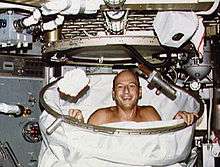
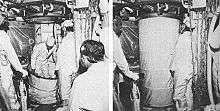
Skylab had a zero-gravity shower system in the work and experiment section of the Orbital Workshop.[79] The shower that had a cylindrical curtain that went from the floor to ceiling, and inside water was dispensed at the push of a button from a nozzle at the end of a flexible hose.[80] In addition there was a vacuum system to suck away water.[80] The floor of the shower (in the usual orientation of this module) had foot restraints.[79] The user had to bring a bottle of pressurized water, which was dispensed through the flexible hose.[79] Liquid soap was used with this shower, and the use of both this soap and the water for showers were carefully planned out as with most items on the station.[79] The first astronaut to use the space shower was Paul J. Weitz (On Skylab 2, the first manned mission )[79] The system was designed for up to 6 pints (3/4 of a gallon or about 2.84 liters) of water per shower.[81] The water was dispensed from a push button nozzle attached to flexible hose, which took water from the personal hygiene tank.[82]
The shower curtain had several hoop rings and soft fabric to contain the water and/or soap that may float in the lack of gravity, which would be sucked up by a vacuum system.[81] Skylab also supplied astronauts with rayon terrycloth towels, which had a color-coded stitching for each crew-member.[83] In all there were 420 towels on board Skylab initially.[79] The normal allotment was that there was enough liquid soap and warm water for one shower per week per person.[84]
"..it took a fair amount longer to use than you might expect, but you come out smelling good."— Astronaut Weitz as quoted in SP-400 Skylab, Our First Space Station[83]
In the 1980s there was a plan to remove the Skylab B to prepare for future space station plans.[81] Scientists would spend 9 months testing and trying to improve the design for the future space station.[81] It was possible to remove it from the National Air and Space museum and use it, since it was a functional flight spare.[81] As it turned out, the Habitation Module was not deployed for what morphed into the International Space Station.
Inhabitants of the Shuttle did not have an enclosed shower, they had to take sponge baths.[85] Similarly though there was device to dispense water, even hot water, and a vacuuming system.[85] One of the big concerns with bathing in space is that the small droplets of water do not cause an electrical short by floating into the wrong area.[85] Like the rest of the interior, especially the crew areas were designed by NASA scientists and engineers, but also with input from famed industrial designer Raymond Loewy, who was employed as a Habitability Consultant.[86][87]
Procedure for operating the shower:[88]
- Fill up the pressurized portable water bottle with hot water and attach that bottle to ceiling
- Connect the hose and pull up the shower curtain
- Spray down with water
- Apply liquid soap and spray more water
- Vacuum up all the fluids and stow items
From start to finish a Skylab shower would take about 2 and half hours.[89] One aspect was not just taking the shower but closing it up afterwards, because it was unwise to leave water droplets floating around.[89]
The vacuum water system fed to a centrifugal separator, filter, and collection bag to allow the system to vacuum up the fluids.[88] Waste water would be injected into a disposal bag which would in turn be put in the waste tank.[52] The fabric material for the shower enclosure was fire-proof beta cloth.[82] The fabric was wrapped around hoops of 109 cm diameter, the top hoop was connected to the ceiling.[82] One of the suggestions was for the nozzle of the suction head to be more flexible, increasing its utitlity.[88] The hose for the spray head connected at the top of the shower.[88] The shower could be collapsed down to the ground when not in use.[88]
A simulated Skylab shower was also used during the 56-day Earth bound Skylab analog mission SMEAT.[90] The report was that they though the in-orbit they thought the astronauts would find it a positive.[90] During SMEAT the astronauts used the shower after heavy exercise.[90]
The Skylab shower was designed and built at the Manned Spaceflight Center.[82]
Cameras and film



There was a variety of hand-held and fixed experiments that used various types of film. In addition to the instruments in the ATM solar observatory, there was 35 and 70 mm film cameras. There was also a TV camera on board, this recorded an image electronically.
It was determined that film was predicted to fog up to due to radiation over the course of the mission.[67] To counter-act this the film was stored in one of several different vaults.[67]
Personal (hand-held) camera equipment:[91]
- Television camera
- Westinghouse color
- 25-150mm zoom
- 16 mm film video camera (Maurer), called the 16 mm Data Acquisition Camera[91] The DAC was capable of very low frame rates, such as for engineering data films, and it had independent shutter speeds and framing rates.[92] It could be powered from a battery or from Skylab itself.[92] It could handle interchangeable lenses, and various lens and also film types were provided during the missions.[92]
- There was different options for frame rates: 2, 4, 6, 12 and 24 frames per second[93]
- It was the Maurer 16 mm DAC
- Available lenses for the film-video camera 5, 10, 18, 25, 75, & 100 mm lenses
- Films for 16 mm DAC
- Ektachrome film
- SO-368 film
- SO-168 film
Film for the DAC were contained in DAC Film Magazine, which contained up to 140 feet (42.7 m) of this base 16 mm film.[94] At 24 framers per second this was enough for 4 minutes of filming, with progressively longer film times with lower frame rates such as 16 minutes at 6 frames per second.[92] The film had to be loaded or unloaded from the DAC in a photographic dark room.[92]
- 35 mm film camera (Nikon)[95]
- 70 mm film camera (Hasselblad)[91]
- This had an electric data camera system with Reseau plate
- Films included
- 70 mm Ektachrome
- SO-368 film
- Lenses: 70 mm lens, 100 mm lens[91]
There was also a pair of Leitz Trinovid 10 x 40 Binoculars modified for use in space to aid in Earth observations.[95]
Additional cameras:
Experiment S190B was the Actron Earth Terrain Camera[95]
S190A was Multispectral Photographic Camera [91]
- This consisted of six cameras 70 mm cameras
- Each was an Itek 70 mm boresighted camera
- Lens was a f/2.8 with a 21.2 degree field of view
Plans for re-use after the last mission

The three crewed Skylab missions used only about 16.8 of the 24 man-months of oxygen, food, water, and other supplies stored aboard Skylab.[99] A fourth manned mission was under consideration, which would have used the launch vehicle kept on standby for the Skylab Rescue mission.[100] This would have been a 20-day mission to boost Skylab to a higher altitude and do more scientific experiments.[100] Another plan was to use a Teleoperator Retrieval System (TRS) launched aboard the Space Shuttle (then under development), to robotically re-boost the orbit.[101] When Skylab 5 was cancelled, it was expected Skylab would stay in orbit until the 1980s, which enough time to overlap with the beginning of Shuttle launches.[101] Other options for launching TRS included the Titan III and Atlas Agena.[101] None of these options received the level of effort and funding needed for execution before Skylab's sooner-than-expected re-entry.[101] Skylab's internal systems were evaluated and tested from the ground, and effort was put into plans for re-using it, as late as 1978.[102]
Though no one returned after the end of the SL-4 mission in February 1974, the crew left a bag filled with supplies to welcome visitors, and left the hatch unlocked.[103] NASA discouraged any discussion of additional visits due to the station's age,[104] but in 1977 and 1978, when the agency still believed the Space Shuttle would be ready by 1979, it completed two studies on reusing the station.[103][105] By September 1978, the agency believed Skylab was safe for crews, with all major systems intact and operational.[106] It still had 180 man-days of water and 420 man-days of oxygen, and astronauts could refill both;[103] the station could hold up to about 600 to 700 man-days of drinkable water and 420 man-days of food.[107] Before SL-4 left they did one more boost, running the Skylab thrusters for 3 minutes which added 11 km in height to its orbit.[108] Skylab was left in a 433 by 455 km orbit on departure.[108] At this time, the NASA-accepted estimate for its re-entry was nine years.[108]
..Calculations made during the mission, based on current values for solar activity and expected atmospheric density, gave the workshop just over nine years in orbit. Slowly at first-dropping 30 kilometers by 1980-and then faster-another 100 kilometers by the end of 1982-Skylab would come down, and some time around March 1983 it would burn up in the dense atmosphere.— SP-4208 Living and Working In Space: A History of Skylab, Chapter 19[108]
The studies cited several benefits from reusing Skylab, which one called a resource worth "hundreds of millions of dollars"[109] with "unique habitability provisions for long duration space flight."[110] Because no more operational Saturn V rockets were available after the Apollo program, four to five shuttle flights and extensive space architecture would have been needed to build another station as large as Skylab's 12,400 cubic feet (350 m3) volume.[111] Its ample size—much greater than that of the shuttle alone, or even the shuttle plus Spacelab[112]—was enough, with some modifications, for up to seven astronauts[113] of both sexes,[114] and experiments needing a long duration in space;[109] even a movie projector for recreation was possible.[110]
Proponents of Skylab's reuse also said repairing and upgrading Skylab would provide information on the results of long-duration exposure to space for future stations.[103] The most serious issue for reactivation was stationkeeping, as one of the station's gyroscopes had failed[115] and the attitude control system needed refueling; these issues would need EVA to fix or replace. The station had not been designed for extensive resupply. However, although it was originally planned that Skylab crews would only perform limited maintenance[116] they successfully made major repairs during EVA, such as the SL-2 crew's deployment of the solar panel[117] and the SL-4 crew's repair of the primary coolant loop.[118][119][120] The SL-2 crew fixed one item during EVA by, reportedly, "hit[ting] it with [a] hammer."[121]
Some studies also said, beyond the opportunity for space construction and maintenance experience, reactivating the station would free up shuttle flights for other uses,[109] and reduce the need to modify the shuttle for long-duration missions.[122] Even if the station were not manned again, went one argument, it would serve as a useful experimental platform.[123]
Shuttle mission plans
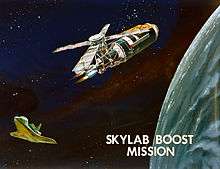
The reactivation would likely have occurred in four phases:[103]
- An early Space Shuttle flight would have boosted Skylab to a higher orbit, adding five years of operational life. The shuttle might have pushed or towed the station, but attaching a booster—the Teleoperator Retrieval System (TRS)—to the station would have been more likely, based on astronauts' training for the task. Martin Marietta won the contract for $26 million to design the apparatus.[124] TRS would contain about three tons of propellant.[125] The remote-controlled booster had TV cameras and was designed for duties such as space construction and servicing and retrieving satellites the shuttle could not reach. After rescuing Skylab, the TRS would have remained in orbit for future use. Alternatively, it could have been used to de-orbit Skylab for a safe, controlled re-entry and destruction.[126]
- In two shuttle flights, Skylab would have been refurbished. In January 1982, the first mission would have attached a docking adapter and conducted repairs. In August 1983, a second crew would have replaced several system components.
- In March 1984, shuttle crews would have attached a solar-powered Power Expansion Package, refurbished scientific equipment, and conducted 30- to 90-day missions using the Apollo Telescope Mount and the earth resources experiments.
- Over five years, Skylab would have been expanded to accommodate six to eight astronauts, with a new large docking/interface module, additional logistics modules, Spacelab modules and pallets, and an orbital vehicle space dock using the shuttle's external tank.
The first three phases would have required about $60 million in 1980s dollars, not including launch costs.
Other options for launching TRS were Titan III or Atlas Agena.[101]
After departure

After a boost of 6.8 miles (10.9 km) by SL-4's Apollo CSM before its departure in 1974, Skylab was left in a parking orbit of 269 miles (433 km) by 283 miles (455 km)[115] that was expected to last until at least the early 1980s, based on estimates of the 11-year sunspot cycle that began in 1976.[127]</ref>[128] NASA first considered as early as 1962 the potential risks of a space station reentry, but decided not to incorporate a retrorocket system in Skylab due to cost and acceptable risk.[129]
The spent 49-ton Saturn V S-II stage which had launched Skylab in 1973 remained in orbit for almost two years, and made an uncontrolled reentry on January 11, 1975.[130] Some debris, most prominently the five heavy J-2 engines, likely survived to impact in the North Atlantic Ocean. Although this event did not receive heavy media or public attention, it was followed closely by NASA and the Air Force, and helped emphasize the need for improved planning and public awareness for Skylab's eventual reentry.
Solar activity

British mathematician Desmond King-Hele of the Royal Aircraft Establishment predicted in 1973 that Skylab would de-orbit and crash to earth in 1979, sooner than NASA's forecast, because of increased solar activity.[128] Greater-than-expected solar activity[131] heated the outer layers of Earth's atmosphere and increased drag on Skylab. By late 1977, NORAD also forecast a reentry in mid-1979;[132] a National Oceanic and Atmospheric Administration (NOAA) scientist criticized NASA for using an inaccurate model for the second most-intense sunspot cycle in a century, and for ignoring NOAA predictions published in 1976.[133]
The reentry of the USSR's nuclear powered Cosmos 954 in January 1978, and the resulting radioactive debris fall in northern Canada, drew more attention to Skylab's orbit. Although Skylab did not contain radioactive materials, the State Department warned NASA about the potential diplomatic repercussions of station debris.[134] Battelle Memorial Institute forecast that up to 25 tons of metal debris could land in 500 pieces over an area 4,000 miles long and 1,000 miles wide. The lead-lined film vault, for example, might land intact at 400 feet per second.[5]
Ground controllers re-established contact with Skylab in March 1978[135] and recharged its batteries.[3] Although NASA worked on plans to reboost Skylab with the Space Shuttle through 1978 and the TRS was almost complete, the agency gave up in December when it became clear that the shuttle would not be ready in time;[124][136] its first flight, STS-1, did not occur until April 1981. Also rejected were proposals to launch the TRS using one or two unmanned rockets[103] or to attempt to destroy the station with missiles.[5]
Re-entry
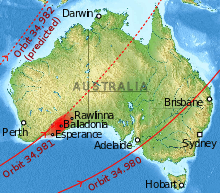
Skylab's demise was an international media event, with merchandising of T-shirts and hats with bullseyes[5] and "Skylab Repellant" with a money-back guarantee,[137] wagering on the time and place of re-entry, and nightly news reports. The San Francisco Examiner offered a $10,000 prize for the first piece of Skylab delivered to its offices; the competing Chronicle offered $200,000 if a subscriber suffered personal or property damage.[3] A Nebraska neighborhood painted a target so the station would have "something to aim for", a resident said.[137]
NASA calculated that the odds of station re-entry debris hitting any human were 1 to 152, which when multiplied by 4 billion becomes 1 in 600 billion for a specific human,[138] although the odds of debris hitting a city of 100,000 or more were 1 to 7 and special teams were readied to head to any country hit by debris and requesting help.[3] The event caused so much panic in the Philippines that then President Ferdinand Marcos appeared on national television to reassure the public.[128]
Charles S. Harlan, Skylab mission controller[5]
A week before re-entry, NASA forecast that it would occur between July 10 to 14, with the 12th the most likely date, and the Royal Aircraft Establishment predicted the 14th.[128] In the hours before the event, ground controllers adjusted Skylab's orientation to try to minimize the risk of re-entry on a populated area.[3] They aimed the station at a spot 810 miles (1,300 km) south southeast of Cape Town, South Africa, and re-entry began at approximately 16:37 UTC, July 11, 1979.[4] The Air Force provided data from a secret tracking system able to monitor the reentry.[139] The station did not burn up as fast as NASA expected. Due to a 4% calculation error, debris landed about 300 miles (480 km) southeast of Perth, Western Australia,[4] and was found between Esperance and Rawlinna, from 31° to 34°S and 122° to 126°E, about 130–150 km (81–93 miles) radius around Balladonia. Residents and an airline pilot saw dozens of colorful fireworks-like flares as large pieces broke up in the atmosphere.[5] The Shire of Esperance facetiously fined NASA A$400 for littering, a fine which remained unpaid for 30 years.[140] The fine was paid in April 2009, when radio show host Scott Barley of Highway Radio raised the funds from his morning show listeners and paid the fine on behalf of NASA.[141][142]
Seventeen-year-old Stan Thornton found 24 pieces of Skylab at his home in Esperance. A Philadelphia businessman flew him, his parents, and his girlfriend to San Francisco, where he collected the Examiner prize.[4][5] In a coincidence for the organizers, the annual Miss Universe pageant was scheduled to be held a few days later, on July 20, 1979 in Perth. A large piece of Skylab debris was displayed on the stage.[143] Analysis of the debris showed that the station had disintegrated 10 miles (16 km) above the Earth, much lower than expected.[5]
After the demise of Skylab, NASA focused on the reusable Spacelab module, an orbital workshop that could be deployed with the Space Shuttle and returned to Earth. The next American major space station project was Space Station Freedom, which was merged into the International Space Station in 1993, and launched starting in 1998. Shuttle-Mir was another project, and led to the U.S. funding Spektr, Priroda, and the Mir Docking Module in the 1990s.
Rockets, rescue, and cancelled missions

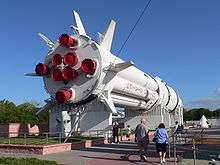
There was a Skylab Rescue mission assembled for the second manned mission to Skylab, but it was not needed. Another rescue mission was assembled for the last Skylab and was also on standby for ASTP. That launch stack might have been used for Skylab 5, what would be the fourth manned Skylab mission but this was cancelled and the SA-209 Saturn IB rocket was put on display at NASA Kennedy Space Center.[144]
Launch vehicles:[144]
- SA-206 (Skylab 2)
- SA-207 (Skylab 3)
- SA-208 (Skylab 4)
- SA-209 (Skylab Rescue, not-launched)
Skylab 5
Skylab 5 would have been a short 20-day mission to conduct more scientific experiments and use the Apollo's Service Propulsion System engine to boost Skylab into a higher orbit. Vance Brand (commander), William B. Lenoir (science pilot), and Don Lind (pilot) would have been the crew for this mission, with Brand and Lind being the prime crew for the Skylab Rescue flights.[145] Brand and Lind also trained for a mission that would have aimed Skylab for a controlled deorbit.[139]
Skylab B
In addition to the flown Skylab space station, a second flight-quality backup Skylab space station had been built during the program. NASA considered using it for a second station in May 1973 or later, to be called Skylab B (S-IVB 515), but decided against it. Launching another Skylab with another Saturn V rocket would have been very costly, and it was decided to spend this money on the development of the Space Shuttle instead. The backup is on display at the National Air and Space Museum in Washington, D.C.
Engineering mock-ups
A full-size training mock-up once used for astronaut training is located at the Lyndon B. Johnson Space Center visitor's center in Houston, Texas. Another full-size training mock-up is at the U.S. Space & Rocket Center in Huntsville, Alabama. Originally displayed indoors, it was subsequently stored outdoors for several years to make room for other exhibits. To mark the 40th anniversary of the Skylab program, the Orbital Workshop portion of the trainer was restored and moved into the Davidson Center in 2013.[146][147] NASA transferred the backup Skylab to the National Air and Space Museum in 1975. On display in the Museum's Space Hall since 1976, the orbital workshop has been slightly modified to permit viewers to walk through the living quarters.[148]
Mission designations
The numerical identification of the manned Skylab missions was the cause of some confusion. Originally, the unmanned launch of Skylab and the three manned missions to the station were numbered SL-1 through SL-4. During the preparations for the manned missions, some documentation was created with a different scheme -- SLM-1 through SLM-3—for those missions only. William Pogue credits Pete Conrad with asking the Skylab program director which scheme should be used for the mission patches, and the astronauts were told to use 1-2-3, not 2-3-4. By the time NASA administrators tried to reverse this decision, it was too late, as all the in-flight clothing had already been manufactured and shipped with the 1-2-3 mission patches.[149]
| Mission | Emblem | Commander | Science Pilot | Pilot | Launch date | Landing date | Duration (days) |
|---|---|---|---|---|---|---|---|
| Skylab 1 SL-1 |  |
unmanned launch of space station | 1973-05-14 17:30:00 UTC |
1979-07-11 16:37:00 UTC |
2248.96 | ||
| Skylab 2 SL-2 (SLM-1) |  |
Pete Conrad | Joseph Kerwin | Paul Weitz | 1973-05-25 13:00:00 UTC |
1973-06-22 13:49:48 UTC |
28.03 |
| Skylab 3 SL-3 (SLM-2) |  |
Alan Bean | Owen Garriott | Jack Lousma | 1973-07-28 11:10:50 UTC |
1973-09-25 22:19:51 UTC |
59.46 |
| Skylab 4 SL-4 (SLM-3) |  |
Gerald Carr | Edward Gibson | William Pogue | 1973-11-16 14:01:23 UTC |
1974-02-08 15:16:53 UTC |
84.04 |
| Skylab 5 | Vance Brand | William B. Lenoir | Don Lind | (Cancelled) | |||
| Skylab Rescue |  |
Vance Brand | Don Lind | (Survivors) | (On Standby) | ||
- SMEAT
The Skylab Medical Experiment Altitude Test or SMEAT was a 56-day (8 week) Earth analog Skylab test.[150] The test had a low-pressure high oxygen-percentage atmosphere but had full gravity due to the effect of being on Earth's surface. The test had a three-man crew with Commander (Crippen), Science Pilot (Bobko), and Pilot (Thornton);[151] there was a focus on medical studies and Thornton was an M.D.[152] They entered a pressure chamber converted to be more a like Skylab on July 26, 1972, and it ended on September 20, 1972.[52]
| Mission | Emblem | Commander | Science Pilot | Pilot | Start date | End date | Duration (days) |
|---|---|---|---|---|---|---|---|
| SMEAT | Bob Crippen | Karol Bobko | William Thornton | July 26, 1972 | September 20, 1972.[52] | 56-days |
Program cost
From 1966 to 1974, the Skylab program cost a total of $2.2 billion, equivalent to $10 billion in 2010 dollars. As its three three-man crews spent 510 total man-days in space, each man-day cost approximately $20 million, compared to $7.5 million for the International Space Station.[153]
Gallery
 The waste management facilities in the backup Skylab at the National Air and Space Museum.
The waste management facilities in the backup Skylab at the National Air and Space Museum. An astronaut mannequin dines aboard the backup Skylab at the Smithsonian NASM.
An astronaut mannequin dines aboard the backup Skylab at the Smithsonian NASM. SkyLab commemorative stamp, Issue of 1974. The commemorative stamp reflects initial repairs to the station, including the parasol sunshade.
SkyLab commemorative stamp, Issue of 1974. The commemorative stamp reflects initial repairs to the station, including the parasol sunshade. Illustration of Skylab configuration with docked Command/Service Module
Illustration of Skylab configuration with docked Command/Service Module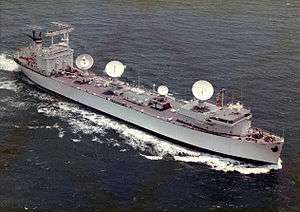 Vanguard (T-AGM-19) seen as a NASA Skylab tracking ship. Note the tracking radar and telemetry antennas.
Vanguard (T-AGM-19) seen as a NASA Skylab tracking ship. Note the tracking radar and telemetry antennas. Robbins medallions issued for Skylab Missions.
Robbins medallions issued for Skylab Missions. Space Center Houston Skylab 1-G Trainer depicting astronaut mannequins in the wardroom and taking a shower
Space Center Houston Skylab 1-G Trainer depicting astronaut mannequins in the wardroom and taking a shower An astronaut mannequin performs a spacewalk alongside the Skylab 1-G Trainer telescope at Space Center Houston
An astronaut mannequin performs a spacewalk alongside the Skylab 1-G Trainer telescope at Space Center Houston An astronaut mannequin exercises in the Skylab 1-G Trainer at Space Center Houston
An astronaut mannequin exercises in the Skylab 1-G Trainer at Space Center Houston
See also
- Timeline of longest spaceflights
- Skylab Medical Experiment Altitude Test (SMEAT)
- Skylab II (proposed space station)
- Splashdown
References
-
 This article incorporates public domain material from websites or documents of the National Aeronautics and Space Administration.
This article incorporates public domain material from websites or documents of the National Aeronautics and Space Administration.
Footnotes
- ↑ "EP-107 Skylab: A Guidebook". NASA. Retrieved February 28, 2017.
- 1 2 "SATURN V LAUNCH VEHICLE FLIGHT EVALUATION REPORT SA-513 SKYLAB 1" (PDF). NASA. 1973. Retrieved 2016-05-29.
- 1 2 3 4 5 "Skylab's Fiery Fall". Time. July 16, 1979. p. 20.
- 1 2 3 4 5 6 Benson & Compton (1983), p. 371.
- 1 2 3 4 5 6 7 8 9 10 Lewis, Richard S. (1984). The Voyages of Columbia: The First True Spaceship. New York: Columbia University Press. pp. 80–82. ISBN 0-231-05924-8 – via Google Books.
- ↑ Heppenheimer (1999), pp. 2–5.
- ↑ Heppenheimer (1999), pp. 55–60.
- ↑ Benson & Compton (1983), p. 23.
- ↑ Benson & Compton (1983), p. 9.
- ↑ Benson & Compton (1983), p. 10.
- ↑ Benson & Compton (1983), p. 14.
- ↑ Benson & Compton (1983), pp. 13–14.
- ↑ MSFC Skylab Orbital Workshop. vol. 1. May 1974. p. 21-1.
- ↑ Heppenheimer (1999), pp. 198–202.
- 1 2 Benson & Compton (1983), p. 17.
- 1 2 Heppenheimer (1999), p. 203.
- ↑ Benson & Compton (1983), pp. 17–19.
- ↑ "MOL (Manned Orbiting Laboratory)".
- ↑ Pike, John. "KH-10, Dorian".
- ↑ Benson & Compton (1983), p. 15.
- ↑ Benson & Compton (1983), pp. 20, 22.
- ↑ Heppenheimer (1999), p. 61.
- ↑ Benson & Compton (1983), p. 20.
- ↑ Benson & Compton (1983), p. 22.
- ↑ Benson & Compton (1983), p. 25.
- ↑ Benson & Compton (1983), p. 30.
- ↑ Benson & Compton (1983), pp. 45–48.
- ↑ Benson & Compton (1983), p. 109.
- ↑ "Space Hut Workshop Planned". The Mid-Cities Daily News. United Press International. January 27, 1967. p. 8 – via Google News.
- ↑ Heppenheimer (1999), pp. 64–65.
- ↑ Heppenheimer (1999), p. 66.
- ↑ Benson & Compton (1983), pp. 109–110.
- ↑ Benson & Compton (1983), p. 130.
- ↑ Benson & Compton (1983), pp. 133–134.
- 1 2 Benson & Compton (1983), p. 137.
- ↑ Benson & Compton (1983), p. 133.
- ↑ Benson & Compton (1983), pp. 139–140.
- ↑ Benson & Compton (1983), pp. 141–142.
- ↑ Belew (1977), p. 82.
- ↑ Benson & Compton (1983), p. 139.
- 1 2 Belew (1977), p. 80.
- ↑ Benson & Compton (1983), pp. 152–158.
- ↑ Belew (1977), p. 30.
- ↑ Benson & Compton (1983), p. 165.
- ↑ Belew, Leland F. & Stuhlinger, Ernst (1973). Skylab: A Guidebook. Washington, DC: National Aeronautics and Space Administration. pp. 24–28. OCLC 702094. EP-107.
- ↑ Bono, Phillip; Gatland, Kenneth (1976). Frontiers of Space (1st American Revised ed.). New York: MacMillan. p. 121.
- ↑ "EP-107 Skylab: A Guidebook. Chapter IV: Skylab Design and Operation". NASA. NASA History. Retrieved 2016-05-29.
- ↑ Benson & Compton (1983), p. 115.
- ↑ Tate, Kara. "Skylab: How NASA's First Space Station Worked" (Infographic). Retrieved April 24, 2014.
- ↑ Benson & Compton (1983), pp. 253–255.
- ↑ "A Solar Prominence Taken by the Skylab Telescope".
- 1 2 3 4 "part3b".
- ↑ Benson & Compton (1983), p. 340.
- ↑ Belew (1977), p. 155.
- ↑ Benson & Compton (1983), pp. 342–344.
- ↑ Benson & Compton (1983), p. 357.
- ↑ Benson & Compton (1983), pp. 307–308.
- ↑ Benson & Compton (1983), pp. 165, 307.
- 1 2 "Living It Up in Space". Time. June 25, 1973. p. 61.
- ↑ Benson & Compton (1983), pp. 306–308.
- ↑ Benson & Compton (1983), pp. 309, 334.
- ↑ Marietta & Bendix (1978), p. 2-7.
- ↑ Martin Marietta & Bendix (1978), p. 2-4.
- ↑ "Darts Game, Skylab". Smithsonian National Air and Space Museum.
- ↑ Belew (1977), pp. 79–80, 134–135.
- ↑ "Skylab Experiments". Marshall Space Flight Center, National Aeronautics and Space Administration. 1973.
- 1 2 3 4 5 6
- 1 2 3 4 5 6
- ↑ Shayler, David (2001-05-28). Skylab: America's Space Station. Springer Science & Business Media. ISBN 9781852334079.
- ↑ O'Toole, Thomas (1979-07-11). "Latest Forecast Puts Skylab Over Southern Canada". The Washington Post. ISSN 0190-8286. Retrieved 2017-01-08.
- ↑ "NASA - Juno Armored Up to Go to Jupiter". www.nasa.gov. Retrieved 2017-01-06.
- 1 2 3 "ch4". history.nasa.gov. Retrieved 2017-01-09.
- 1 2 "ch4".
- ↑ Times, Special To The New York (1974-01-23). "Skylab's Gyroscope Has Worst Seizure; Breakdown Feared". The New York Times. ISSN 0362-4331. Retrieved 2017-01-11.
- 1 2 3
- 1 2 "p46".
- 1 2 3 4 5 "ch3".
- 1 2 3 4 5 "Chapter 3, We Can Fix Anything.". NASA.gov.
- 1 2 3 4 5 6 "ch5". history.nasa.gov. Retrieved 2017-01-18.
- 1 2 "Space History Photo: Showering on Skylab". Space.com. Retrieved 2017-01-18.
- 1 2 3 4 5 Clarity, James F.; Jr, Warren Weaver (1984-11-26). "BRIEFING; Bathing in Space". The New York Times. ISSN 0362-4331. Retrieved 2017-01-18.
- 1 2 3 4 "part3b". history.nasa.gov. Retrieved 2017-01-19.
- 1 2 "ch5".
- ↑
- 1 2 3 "Space Station | The Station | Living in Space". www.pbs.org. Retrieved 2017-01-18.
- ↑ Torchinsky, Jason. "Why Skylab Was America's First And Best Home In Space". Jalopnik. Retrieved 2017-01-18.
- ↑ Mohon, Lee (2013-11-05). "Raymond F. Loewy, Contributor to Spacecraft Design". NASA. Retrieved 2017-01-18.
- 1 2 3 4 5 Häuplik-Meusburger, Sandra (2011-10-18). Architecture for Astronauts: An Activity-based Approach. Springer Science & Business Media. ISBN 9783709106679.
- 1 2 Guastello, Stephen J. (2013-12-19). Human Factors Engineering and Ergonomics: A Systems Approach, Second Edition. CRC Press. ISBN 9781466560093.
- 1 2 3 Shayler, David (2001-05-28). Skylab: America's Space Station. Springer Science & Business Media. ISBN 9781852334079.
- 1 2 3 4 5 "ch5b". history.nasa.gov. Retrieved 2017-01-14.
- 1 2 3 4 5 (2.1-1)
- ↑ "ch5b". history.nasa.gov. Retrieved 2017-01-18.
- ↑ "Handbook of Pilot Operational Equipment for Manned Spaceflight - Camera Lens".
- 1 2 3 "ch5b".
- ↑ "OBSERVATION OF THE EARTH ORBITAL AND SUORBITAL SPACEFLIGHT MISSIONS".
- 1 2 "Nikon - Imaging Products - Legendary Nikons / Vol. 12. Special titanium Nikon cameras and NASA cameras".
- ↑ "OBSERVATION OF THE EARTH ORBITAL AND SUORBITAL SPACEFLIGHT MISSIONS". eol.jsc.nasa.gov. Retrieved 2017-01-14.
- ↑ Portree, David S. F. "Skylab Rescue Plan (1972)".
- 1 2 "Skylab 5".
- 1 2 3 4 5 "Skylab's Untimely Fate".
- ↑
- 1 2 3 4 5 6 Oberg, James (February–March 1992). "Skylab's Untimely Fate". Air & Space.
- ↑ Benson & Compton (1983), pp. 335, 361.
- ↑ Martin Marietta & Bendix (1978), p. 3-1.
- ↑ Martin Marietta & Bendix (1978), p. 3-2.
- ↑ Martin Marietta & Bendix (1978), p. 2-7.
- 1 2 3 4 "ch19".
- 1 2 3 Martin Marietta & Bendix (1978), p. 1-13.
- 1 2 Martin Marietta & Bendix (1978), p. 3-11.
- ↑ Martin Marietta & Bendix (1978), pp. 1-12 to 1-13.
- ↑ Martin Marietta & Bendix (1978), p. 2-8.
- ↑ Martin Marietta & Bendix (1978), p. 2-31.
- ↑ Martin Marietta & Bendix (1978), p. 3-14.
- 1 2 Benson & Compton (1983), p. 361.
- ↑ Belew (1977), p. 34.
- ↑ Belew (1977), pp. 73–75.
- ↑ Benson & Compton (1983), p. 317.
- ↑ Belew (1977), p. 130.
- ↑ Martin Marietta & Bendix (1978), p. 3-21.
- ↑ Belew (1977), p. 89.
- ↑ Martin Marietta & Bendix (1978), pp. 2-9 to 2-10.
- ↑ Martin Marietta & Bendix (1978), p. 2-61.
- 1 2 "Science: Skylab Will Come Tumbling Down". Time. January 1, 1979. p. 72.
- ↑ Skylab Reboost Module
- ↑ Dempewolff, Richard F. (August 1978). "Our Growing Junkyard in Space". Popular Mechanics. p. 57. Retrieved February 17, 2012 – via Google Books.
- ↑ Edelson (1979), p. 65
- 1 2 3 4 "Foreign Astrologers, Soothsayers Make Skylab Predictions". Spartanburg Herald. Associated Press. 1979-07-04. pp. B8. Retrieved 1 September 2016.
- ↑ Benson & Compton (1983), pp. 127–129.
- ↑ "Skylab Rocket Debris Falls in Indian Ocean". Chicago Tribune. January 11, 1975. p. 6. Retrieved October 22, 2014.
- ↑ Benson & Compton (1983), p. 362.
- ↑ Edelson (1979), p. 65
- ↑ Benson & Compton (1983), pp. 362–363.
- ↑ Benson & Compton (1983), p. 363.
- ↑ Edelson (1979), pp. 65-66
- ↑ Benson & Compton (1983), pp. 363–367.
- 1 2 Carrier, Jim (1979-07-08). "Some find Skylab good for 'Skylaughs'". The Kokomo Tribune. Associated Press. p. 37. Retrieved 1 September 2016.
- ↑ Coates, James (July 1, 1979). "Skylab Danger Isn't as Small as NASA Hints". Boca Raton News. p. 7 – via Google News.
- 1 2 "Don L. Lind Oral History Transcript" (PDF). Space Center Oral History Project. NASA Johnson. May 27, 2005.
- ↑ O'Neill, Ian (July 19, 2009). "Celebrating July 13, 'Skylab-Esperance Day'". Discovery News.
- ↑ Siemer, Hannah (April 17, 2009). "Littering Fine Paid". The Esperance Express. Archived from the original on July 11, 2012.
- ↑ Sutherland, Paul (July 5, 2009). "NASA’s Litter Bill Paid 30 Years On". Skymania News.
- ↑ "Venezuela Wins for the First Time: The Pageant Does Down Under". Critical Beauty. Archived from the original on December 21, 2004.
- 1 2 Kruse, Richard. "Historic Spacecraft - Skylab".
- ↑ Wade, Mark. "Skylab 5". Astronautix. Retrieved February 4, 2011.
- ↑ "Museum Galleries". Archived from the original on October 29, 2013.
- ↑ "Skylab Engineering Mockup Moves into Saturn V Hall at Space and Rocket Center After 10 Years Outdoors". AL.com.
- ↑ "Orbital Workshop, Skylab, Backup Flight Unit". Smithsonian Institution National Air and Space Museum.
- ↑ "Skylab Numbering Fiasco". WilliamPogue.com.
- ↑ "ch8".
- ↑ Administrator, NASA (March 12, 2015). "Astronaut Crippen With Skylab Training Hardware".
- ↑ "Skylab Medical Experiments Altitude Test (SMEAT)".
- ↑ Lafleur, Claude (March 8, 2010). "Costs of US Piloted Programs". The Space Review. Retrieved February 18, 2012. See author's correction in comments section.
Works cited
- Belew, Leland. F., ed. (1977). Skylab, Our First Space Station. Washington, DC: National Aeronautics and Space Administration Scientific and Technical Information Office. OCLC 2644423. SP-400.
- Benson, Charles Dunlap & Compton, William David (1983). Living and Working in Space: A History of Skylab. Washington, DC: National Aeronautics and Space Administration Scientific and Technical Information Office. OCLC 8114293. SP-4208.
- Heppenheimer, T. A. (1999). The Space Shuttle Decision: NASA's Search for a Reusable Space Vehicle. Washington, DC: National Aeronautics and Space Administration History Office. OCLC 40305626. SP-4221.
- Martin Marietta & Bendix (September 1978). Skylab Reuse Study. Washington, DC: National Aeronautics and Space Administration.
- Edelson, Edward (January 1979). "Saving Skylab: The Untold Story". Popular Science – via Google Books.
Further reading
- Newkirk, Roland W.; Ertel, Ivan D.; Brooks, Courtney G. (1977). Skylab: A Chronology. National Aeronautics and Space Administration. SP-4011.
- SP-402 A New Sun: The Solar Results from Skylab
- Skylab Mission Evaluation - NASA report (PDF format)
- Skylab Reactivation Mission Report 1980 - NASA report (PDF format)
External links
| Wikimedia Commons has media related to Skylab. |
- Voices of Oklahoma interview with William Pogue. First person interview conducted with William Pogue on August 8, 2012. Original audio and transcript archived with Voices of Oklahoma oral history project.
NASA
- NASA History Series Publications (many of which are on-line)
- Skylab: Four Rooms Earth View on YouTube NASA Educational Film
- Airlock Module under construction (1971) (Medium)
- Airlock and Docking Module together (1972) (Medium)
- Skylab Crew Quarters Illustration
- Apollo (in foreground) and Skylab space food (M487)
Third party
- eoPortal: Skylab
- Historic Spacecraft: Skylab
- Skylab reboost module
- Skylab Reentry (Chapter 9 of SP-4208)
- Skylab cutaway drawing from Encyclopædia Britannica
- Cutaway line drawing of Skylab
- Skylab "Christmas tree"
